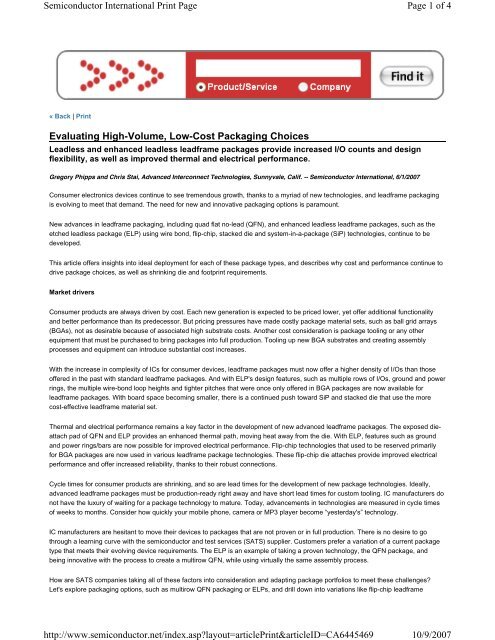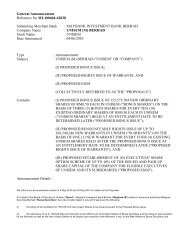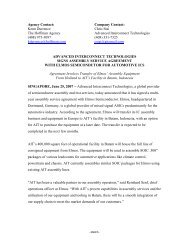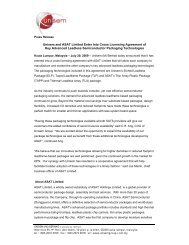Evaluating High-Volume, Low-Cost Packaging Choices ... - Unisem
Evaluating High-Volume, Low-Cost Packaging Choices ... - Unisem
Evaluating High-Volume, Low-Cost Packaging Choices ... - Unisem
Create successful ePaper yourself
Turn your PDF publications into a flip-book with our unique Google optimized e-Paper software.
Semiconductor International Print Pagehttp://www.semiconductor.net/index.asp?layout=articlePrint&articleID=CA6445469Page 2 of 410/9/2007packages, stacked die leadframe packages and SiP options, such as QFN-MCM.Multirow QFN packagesMultirow QFN packaging and ELPs offer benefits of a greater I/O density, design flexibility and improved electrical performance (Fig.1 ). The small size of these packages, coupled with their thermal and electrical performance, make them well suited for handheld andportable communication applications where high-performance packages are required.1. The etched leadless package (ELP) takes quad flat no-lead(QFN) packaging to the next level with multiple rows of I/Osand a smaller footprint.ELP offers flexibility for increased I/O integration and delivers strong interconnectivity from chip to board, allowing for thermal andelectrical enhancements with robust reliability. Its multirow capability provides a cost advantage per I/O that is significant whencompared with QFN and two-layer laminate package options. Specifically, ELPs can be configured with multiple rows of leadframeposts and power/ground ring options, along with the ability to isolate signal pads and enable I/O signal routing that standard QFNscannot offer. This provides increased electrical performance with shorter wire lengths, which reduces wire inductance. Overall, thepackage has a higher I/O count in a smaller package.SiP leadframe packagesQFN SiP technology has emerged as a low-cost alternative to substrate-based multichip modules (MCMs) and system-on-a-chip (SoC)designs without a drop in reliability (Fig. 2 ). These SiP solutions offer superior flexibility, which enable wireless manufacturers to moreeasily support multiple standards, modes and technologies.
Semiconductor International Print Pagehttp://www.semiconductor.net/index.asp?layout=articlePrint&articleID=CA6445469Page 3 of 410/9/20072. The QFN system-in-a-package (SiP) provides a higher levelof integration, while decreasing the number of components.What are the ideal deployment scenarios for QFN? The number of IC elements is in direct correlation with the complexity of the circuitfunctionality. If a product must be integrated in a wide range of applications, the number and intricacy of the challenges are amplified.The packaging industry has learned that it is virtually impossible to put all of this functionality on one IC. This puts package assemblersin a situation where they must take ICs and passives from several suppliers, resulting in the need to design and assemble this circuitryon the motherboard to support the required functionality. By implementing SiP technology, the complexity is transferred to the SiPinstead of the system's motherboard.The most important benefit of SiP technology is the integrated functionality of adding the support circuitry to the SiP. Most OEMs arecurrently downsizing their manufacturing operations in cost-cutting measures, demanding that their component suppliers provide avalue-added product. These OEMs are now turning to packaging subcontractors as a value-added resource for addressinginnumerable technical challenges associated with SiP technology.OEMs have discovered that with outsourcing the assembly of SiP, they can specify a single integrated component instead of a discreteactive device plus multiple passives.This integration can be implemented across multiple platforms to give the OEM the benefit of economies of scale that translate intolower costs. By using subcontractors to perform assembly tasks, the normal overhead associated with SiP manufacturing is moved to alower-cost operating center. And because the subcontractor builds for multiple customers, the OEM is only charged for its portion of thelines. As the OEM's volumes undergo inevitable seasonal or market-driven variations, there is no longer a non-revenue-generatingoverhead burden.Stacked die leadframe packagesShrinking sizes of consumer applications have placed system board space at a premium. With stacked die leadframes, the packagefootprint stays the same and allows for additional functionality (Fig. 3 ). This functionality is added by increasing package efficiency inthe Z direction. In turn, these single device packages can be combined to free up space on a printed circuit board (PCB).3. The QFN stacked die SiP is an ideal solution for spaceconsciousdesigns, offering two or more die in a singlepackage.Typical stacking configurations include two die (memory and logic) in one package, with the number of packages increasing thestacking to three or four devices. Emerging and future stacked die packages currently contain more than four devices. However, thisinvolves design- and assembly-related challenges, including signal-to-lead compatibility and die-stacking assembly issues like waferthinning/preparation, die-attach capability/control, epoxy bleed, outgassing, low-loop requirement with high consistency, wire bondingon overhang die, etc. This is driving assembly equipment and material advancements in the industry, and special die-attach materials,such as die-attach film and epoxy with spacers, are being used to improve bond line control. As a result, new mold compounds areneeded that are compatible with the internal configuration; they must also be able to ensure the highest level of reliability. This, in turn,
Semiconductor International Print Pagehttp://www.semiconductor.net/index.asp?layout=articlePrint&articleID=CA6445469Page 4 of 410/9/2007is prompting companies to upgrade their assembly equipment, including wire bond machines and die attach, to handle today'sassembly challenges.Flip-chip leadframe packagesEliminating wire bonds and providing a direct signal path from the bump to the leadframe post, which mates to the PCB, increases theperformance of flip-chip leadframe packages, such as etched leadless grid arrays (ELGAs). This improves the reliability of bothpackage types, because they can achieve a higher moisture sensitivity level (MSL) rating. Beyond that, flip-chip leadframes offerimproved electrical performance, compared with their wire bond counterparts. This allows for lower inductance, resistance and highercapacitance values to be achieved, as well as a shorter time delay for high-speed applications.There is also a real estate savings advantage, which is needed in most of today's consumer applications. Manufacturers can now putadditional I/Os in a given die size, making it possible to shrink the die and ultimately give more die per wafer, which provides an overallcost reduction.ConclusionManufacturers of existing and emerging wireless and smaller consumer applications are reaping the benefits of these new enhancedleadless packages. Specifically, leadless and enhanced leadless packages provide increased I/O counts and design flexibility, as wellas improved thermal and electrical performance, which result in superior package reliability.ELP and QFN take advantage of the existing infrastructure and use standard material sets, making leadless packages an attractivealternative for many applications, such as cell phones and the portable consumer markets (PDAs, camcorders, cameras and MP3players). The industry will continue to see lower costs and increased performance, driving packaging choices in an industry thatcontinually demands shrinking die sizes and smaller package footprint requirements.Author InformationGregory Phipps is the design manager at Advanced Interconnect Technologies Inc . He is a noted expert in single- and multilayerTBGA, PBGA, CSP, SiP and flip-chip designs, having worked in the PCB/BGA design industry for the past 16 years, nine of whichwere spent focusing on array package design.Chris Stai is Advanced Interconnect Technologies' business development manager, and oversees all external communications for thecompany. Stai holds a B.S. in business administration from California State University, Stanislaus.« Back | Print© 2007, Reed Business Information, a division of Reed Elsevier Inc. All Rights Reserved.Advertisement








